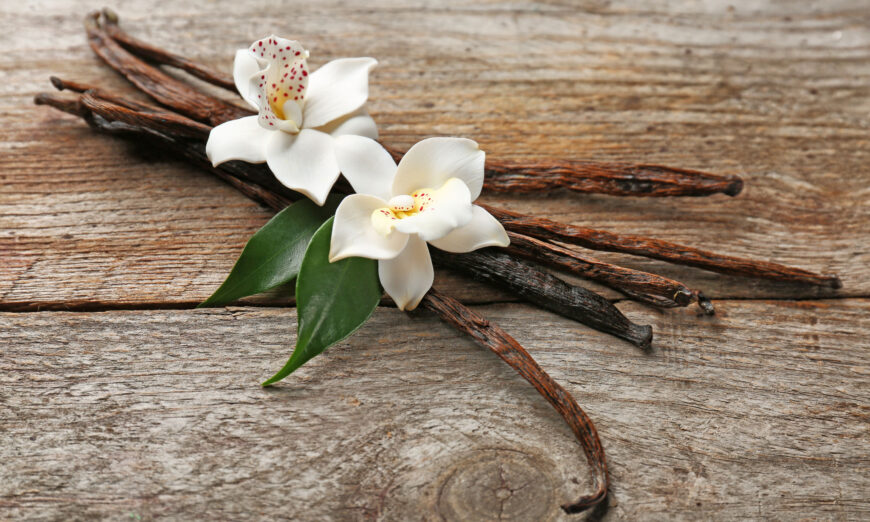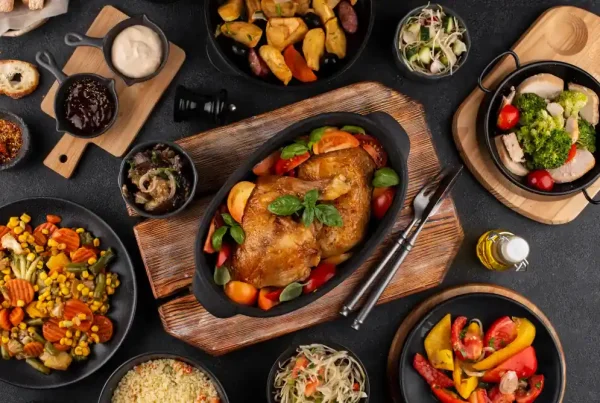Vanilla has a long history of diverse usage, both culinary and medicinal. Its medicinal benefits and applications are based on the chemical properties of vanillin and vanillic acid, vanilla’s active ingredients. Although the medicinal uses have faded into history, recent research has brought them back to the light. The intense aromatic flavor is what vanilla is known for, but its medicinal properties have some surprising potential applications.
Vanilla is the world’s most popular flavor and the second most expensive botanical after saffron. Vanilla is extracted from the Vanilla planifolia orchid pods and comprises over 200 compounds, but its characteristic flavor and fragrance primarily come from vanillin.
The most valued vanillas come from the Mexican vanilla bean, prized for its rich flavor and aroma. Although several other countries produce somewhat inferior vanilla, Madagascar is the largest producer of natural vanilla, with 75 percent of today’s world production, according to a joint paper published in 2021.
History
Vanilla’s medicinal uses go back to Mesoamerica, where the Maya discovered and cultivated the vanilla orchid. They used green vanilla beans or pods to treat poisonous insect bites and to heal wounds. Women were given a vanilla tincture to calm hysteria and depression.
After conquering the Aztec Empire in the 16th century, the Spanish conquistadors became very interested in their newly acquired country’s plants and their botanical properties. They produced manuscripts, written mainly by the monks who came later, that documented the medicinal applications of these plants, including vanilla. After Hernán Cortés, the Spanish conqueror of Mexico, brought the vanilla bean back to Europe, it became popular as a stimulant and aphrodisiac. Vanilla eventually appeared in the European pharmacopeia in the 1700s.
Vanilla Production
Most people have heard of two types of vanilla: the extract used for cooking, and the essential oil used for cosmetic and medicinal purposes.
Vanilla does not produce an “essential oil,” but there are methods to extract specific compounds from the vanilla pods to create an essential-oil product. These extractions vary in scent and strength based on the particular plants harvested and the quality of the fermented pods.
Vanilla Extract
Pure vanilla extract is expensive and in high demand. Because of this, imitation or synthetic vanilla extract has become popular. It is a cheaper food flavoring made from less expensive ingredients such as clove oil, wood pulp, coal tar, and petroleum byproducts.
Commercial producers extract vanillin from the pod through a cold press, steam, microwave, ultrasound, or enzymes. The vanillin is then mixed with an alcohol water base to produce pure vanilla extract. Synthetic vanilla extract contains only small amounts of vanillin and thus has none of the other health benefits that pure natural vanilla extract or essential oil has.
Vanilla Essential Oil
The essential oil from the vanilla bean is obtained via solvent extraction, which produces a semi-solid concentrate referred to as vanilla oleoresin, used in the perfume industry. This concentrate is not edible. Oleoresin is used to make vanilla absolute which is of thinner consistency and easily dissolved in a carrier oil such as coconut, almond, or jojoba. Edible vanilla essential oil is an infusion of the vanilla bean into an edible oil such as almond or grapeseed oil. The best commercial edible vanilla oil should be organic using a food-grade oil or, in the case of vanilla tinctures, food-grade liquor such as vodka. Edible oils sold commercially must state they are made for consumption. These edible vanilla oils can enhance the flavor of foods and drinks or be used medicinally.
Properties
While the medicinal properties of vanilla have been recognized in many cultures for centuries, scientific evaluations have only been published in the last 15 years. Studies have revealed other properties, including vanilla’s potential use as a natural tranquilizer, an analgesic, febrifuge, and digestive, as well as an antibacterial, antioxidant, and antirheumatic. Botanicals Online, a collaborative group of medical, pharmaceutical, and botanical experts, has compiled publications reporting these characteristics.
Medicinal Uses
According to the King’s American Dispensary of 1898, vanilla as an aromatic was used to excite the brain to help prevent sleep. It was also recommended to increase muscular energy and to excite the sexual organs. Instructions from the Dispensary begin with pulverizing pieces of dried vanilla pods to make a powder mixed with sugar. Infusions of this powder were made using boiling water. Half a fluid ounce of this infusion was to be taken three to four times a day to relieve rheumatism, hysteria, and fever.
Some cultures today believe in the power of plants and their applications for various conditions using powders, tinctures, and ointments. So far, little research exists documenting vanilla’s use and scientific results in clinical settings. However, promising results have emerged from laboratory studies using animals.
Antioxidant phenols, tannins, vanillic acid, and vanillin show promise in treating inflammation and aging. The aromatic volatile compounds eugenol, limonene, coumarin, salicylate, and benzaldehyde help vanilla oil treat insomnia, depression, and anxiety disorders. As an analgesic, it is helpful for muscle and stomach pain and headaches. As a digestive, it can be beneficial for gastritis, heartburn, and gall bladder disorders.
Research
Interest in using vanilla for therapeutic purposes has increased. The 2021 joint article from researchers in India and Australia is a compilation of some of the recent research reported in the literature.
“We summarize the potential bioactivates of vanillin and its derivative with an aim to change the perspective from being a popular flavor to a new age therapeutics molecule,” the authors wrote in the article.
The many therapeutic properties of vanilla reported include antioxidant, anti-inflammatory, anticancer, diabetes protection, antifungal, antibacterial, modulation of antibiotic activity, and antiviral. The applicability as an active pharmaceutical ingredient may be helpful for neurodegeneration, inhibition of tumor formation, antibiotic resistance, modifying sickle-cell anemia, tissue engineering, and for viral infections.
Other recent clinical studies have looked at vanillin’s antioxidant, anti-inflammatory, and antimicrobial properties in preventing and reversing skin aging and damage caused by free radicals, as well as treating acne. Another study researched vanillin for protection against and treatment of gastric ulcers.
The sweet smell of vanilla has been tried as an olfactory stimulant in newborns with some success in decreasing the frequency of sleep apnea.
Side Effects
Essential oils, including vanilla oil, are very potent and must be diluted with carrier oil before being applied to the skin to reduce the risk of irritation or a skin reaction. There is little information regarding other side effects, but most practitioners consider it a natural plant that is useful and well-tolerated by the body. If ingesting the oil, be sure it is food-grade and preferably organic. Read the labels.
Make Your Own Vanilla Oil
It is easy to make your own homemade vanilla oil infusion. Start with quality vanilla beans that have been dried and fermented correctly. Slice several pods into thin sections, then cut them into small pieces. Place pieces in a clean jar with a lid. Fill the jar with your preferred neutral oil, such as grapeseed or almond oil. Let the mixture infuse at room temperature for at least three weeks or longer. When ready, pour the solution through a sieve into a fresh jar. The resulting oil infusion can then be used to add to a bath, used on your skin, or in an aromatherapy diffuser.
If you have used organic beans and oil, this can be used on food or in drinks to enhance their flavor. If you infuse the beans into an edible liquor such as vodka, you will have an excellent digestive or tincture for headaches and fevers.
Parting Thoughts
One last comment about dosages, especially if the vanilla is to be taken internally. Do not directly ingest vanilla extract, which may contain harmful substances depending on the quality of the product. As with other essential oils, the correct amount depends on the user’s age and health condition. There is not enough scientific information about vanilla doses. However, many producers of essential-oil products base their suggested dosages on years of experience.
Because historical uses of vanilla for medicinal relief of some symptoms are still under investigation, some people may be cautious or against using vanilla for anything other than culinary purposes. Follow the manufacturer’s directions and consult a health care professional if you have questions.
Source: The Medicinal Properties of Vanilla: From Ancient History to Modern Use













